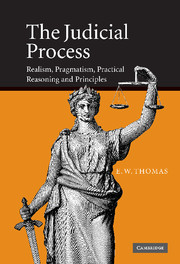Book contents
- Frontmatter
- Contents
- Preface
- 1 Introduction
- 2 Muddling along
- 3 The ‘curse’ of formalism
- 4 Legal fundamentalism
- 5 The idolatry of certainty
- 6 The piety of precedent
- 7 The foibles of precedent – a case study
- 8 There is no impersonal law
- 9 So, what is the law?
- 10 The constraints on the judiciary
- 11 Towards a new judicial methodology
- 12 Of realism and pragmatism
- 13 Of … practical reasoning and principles
- 14 Taking law seriously
- 15 A theory of ameliorative justice
- Subject index
- Authors index
3 - The ‘curse’ of formalism
Published online by Cambridge University Press: 15 July 2009
- Frontmatter
- Contents
- Preface
- 1 Introduction
- 2 Muddling along
- 3 The ‘curse’ of formalism
- 4 Legal fundamentalism
- 5 The idolatry of certainty
- 6 The piety of precedent
- 7 The foibles of precedent – a case study
- 8 There is no impersonal law
- 9 So, what is the law?
- 10 The constraints on the judiciary
- 11 Towards a new judicial methodology
- 12 Of realism and pragmatism
- 13 Of … practical reasoning and principles
- 14 Taking law seriously
- 15 A theory of ameliorative justice
- Subject index
- Authors index
Summary
Timur, the barbarian
In the story that follows the reader may find the line between that which is fact and that which is fiction to be somewhat indistinct. There can be absolutely no doubt that the truth does fade into the apocryphal.
Timur, otherwise known as Tamerlane (a corruption of ‘Timur-i-lenk’, the Persian for ‘Timur the Lame’, because he limped from a battle wound), was one of the most brutal and aggressive conquerors in all history – at least up to the twentieth and present centuries. He rose from obscurity in a Turko-Mongolian tribe in the fourteenth century to establish an empire stretching from Anatolia to Delhi. His wars of conquest were marked by unbelievable brutality, butchery, carnage and wanton destruction. Timur falsely claimed to be a descendant of Genghis Khan, and openly modelled himself on that infamous conqueror. But Timur outdid his personal afflatus in all aspects of barbaric cruelty.
Timur besieged the City of Sivas – or ancient Sebasteia. For a time the inhabitants resisted. Then the soldiers agreed to surrender to Timur if he would shed no blood. Timur quickly agreed. The soldiers surrendered, and Timur shed no blood. He simply buried them alive!
What is the message: that black letter literalism is barbaric? Perhaps, but I must admit that this is not quite the message which I had in mind.
- Type
- Chapter
- Information
- The Judicial ProcessRealism, Pragmatism, Practical Reasoning and Principles, pp. 54 - 74Publisher: Cambridge University PressPrint publication year: 2005

